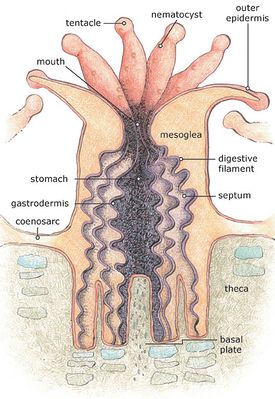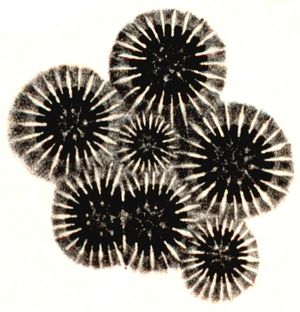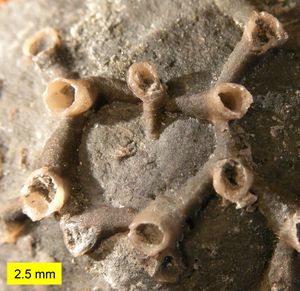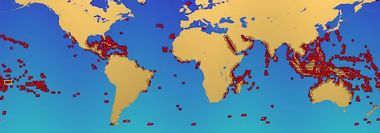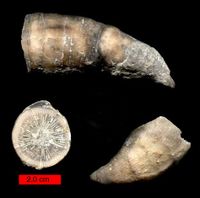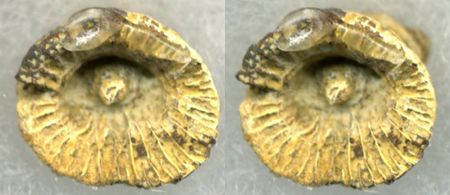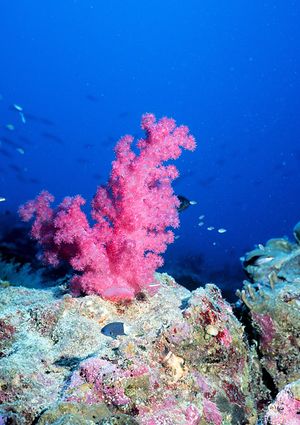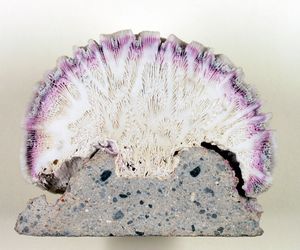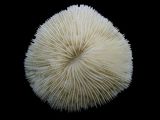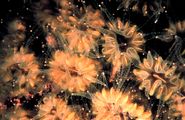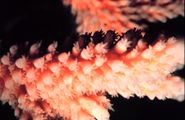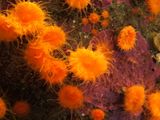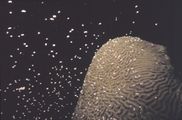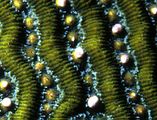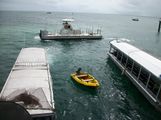مرجان (حيوان)
| Corals | |
|---|---|
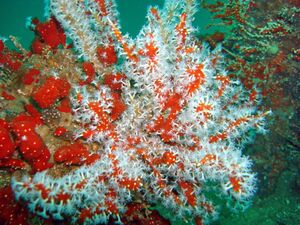
| |
| Red sea fingers (Alcyonium glomeratum), a soft coral | |
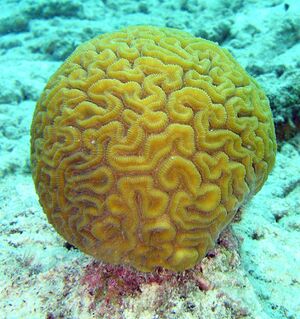
| |
| Grooved brain coral (Diploria labyrinthiformis), a hard coral | |
| التصنيف العلمي | |
| أصنوفة غير معروفة (أصلحها): | Anthozoa |
| Subdivision | |
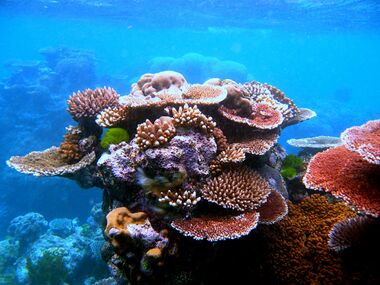
المرجان Coral، جوفمعي بحري يعيش مفردا أو في مستعمرات، ويفرز هيكلا كلسيا خارجيا ليكون مايعرف بالشعب المرجاني coral reef.[1]
A coral "group" is a colony of very many genetically identical polyps. Each polyp is a sac-like animal typically only a few millimeters in diameter and a few centimeters in height. A set of tentacles surround a central mouth opening. Each polyp excretes an exoskeleton near the base. Over many generations, the colony thus creates a skeleton characteristic of the species which can measure up to several meters in size. Individual colonies grow by asexual reproduction of polyps. Corals also breed sexually by spawning: polyps of the same species release gametes simultaneously overnight, often around a full moon. Fertilized eggs form planulae, a mobile early form of the coral polyp which, when mature, settles to form a new colony.
Although some corals are able to catch plankton and small fish using stinging cells on their tentacles, most corals obtain the majority of their energy and nutrients from photosynthetic unicellular dinoflagellates of the genus Symbiodinium that live within their tissues. These are commonly known as zooxanthellae and give the coral color. Such corals require sunlight and grow in clear, shallow water, typically at depths less than 60 متر (200 أقدام; 33 fathom). Corals are major contributors to the physical structure of the coral reefs that develop in tropical and subtropical waters, such as the Great Barrier Reef off the coast of Australia. These corals are increasingly at risk of bleaching events where polyps expel the zooxanthellae in response to stress such as high water temperature or toxins.
Other corals do not rely on zooxanthellae and can live globally in much deeper water, such as the cold-water genus Lophelia which can survive as deep as 3،300 متر (10،800 أقدام; 1،800 fathom).[2] Some have been found as far north as the Darwin Mounds, northwest of Cape Wrath, Scotland, and others off the coast of Washington state and the Aleutian Islands.
التبويب
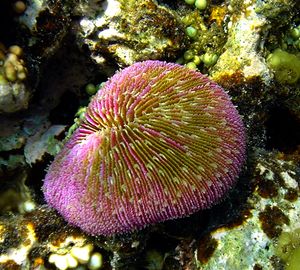
The classification of corals has been discussed for millennia, owing to having similarities to both plants and animals. Aristotle's pupil Theophrastus described the red coral, korallion, in his book on stones, implying it was a mineral, but he described it as a deep-sea plant in his Enquiries on Plants, where he also mentions large stony plants that reveal bright flowers when under water in the Gulf of Heroes.[3] Pliny the Elder stated boldly that several sea creatures including sea nettles and sponges "are neither animals nor plants, but are possessed of a third nature (tertia natura)".[4] Petrus Gyllius copied Pliny, introducing the term zoophyta for this third group in his 1535 book On the French and Latin Names of the Fishes of the Marseilles Region; it is popularly but wrongly supposed that Aristotle created the term.[4] Gyllius further noted, following Aristotle, how hard it was to define what was a plant and what was an animal.[4] The Babylonian Talmud refers to coral among a list of types of trees, and the 11th century French commentator Rashi describes it as "a type of tree (מין עץ) that grows underwater that goes by the (French) name "coral."[5]
The Persian polymath Al-Biruni (d.1048) classified sponges and corals as animals, arguing that they respond to touch.[6] Nevertheless, people believed corals to be plants until the eighteenth century, when William Herschel used a microscope to establish that coral had the characteristic thin cell membranes of an animal.[7]
Presently, corals are classified as species of animals within the sub-classes Hexacorallia and Octocorallia of the class Anthozoa in the phylum Cnidaria.[8] Hexacorallia includes the stony corals and these groups have polyps that generally have a 6-fold symmetry. Octocorallia includes blue coral and soft corals and species of Octocorallia have polyps with an eightfold symmetry, each polyp having eight tentacles and eight mesenteries. The group of corals is paraphyletic because the sea anemones are also in the sub-class Hexacorallia.
التشريح
For most of their life corals are sessile animals of colonies of genetically identical polyps. Each polyp varies from millimeters to centimeters in diameter, and colonies can be formed from many millions of individual polyps. Stony coral, also known as hard coral, polyps produce a skeleton composed of calcium carbonate to strengthen and protect the organism. This is deposited by the polyps and by the coenosarc, the living tissue that connects them. The polyps sit in cup-shaped depressions in the skeleton known as corallites. Colonies of stony coral are very variable in appearance; a single species may adopt an encrusting, plate-like, bushy, columnar or massive solid structure, the various forms often being linked to different types of habitat, with variations in light level and water movement being significant.[9]
The body of the polyp may be roughly compared in a structure to a sac, the wall of which is composed of two layers of cells. The outer layer is known technically as the ectoderm, the inner layer as the endoderm. Between ectoderm and endoderm is a supporting layer of gelatinous substance termed mesoglea, secreted by the cell layers of the body wall.[10] The mesoglea can contain skeletal elements derived from cells migrated from the ectoderm.
The sac-like body built up in this way is attached to a hard surface, which in hard corals are cup-shaped depressions in the skeleton known as corallites. At the center of the upper end of the sac lies the only opening called the mouth, surrounded by a circle of tentacles which resemble glove fingers. The tentacles are organs which serve both for tactile sense and for the capture of food.[10] Polyps extend their tentacles, particularly at night, often containing coiled stinging cells (cnidocytes) which pierce, poison and firmly hold living prey paralyzing or killing them. Polyp prey includes plankton such as copepods and fish larvae. Longitudinal muscular fibers formed from the cells of the ectoderm allow tentacles to contract to convey the food to the mouth. Similarly, circularly disposed muscular fibres formed from the endoderm permit tentacles to be protracted or thrust out once they are contracted.[10] In both stony and soft corals, the polyps can be retracted by contracting muscle fibres, with stony corals relying on their hard skeleton and cnidocytes for defense. Soft corals generally secrete terpenoid toxins to ward off predators.[9]
In most corals, the tentacles are retracted by day and spread out at night to catch plankton and other small organisms. Shallow-water species of both stony and soft corals can be zooxanthellate, the corals supplementing their plankton diet with the products of photosynthesis produced by these symbionts.[9] The polyps interconnect by a complex and well-developed system of gastrovascular canals, allowing significant sharing of nutrients and symbionts.[11]
The external form of the polyp varies greatly. The column may be long and slender, or may be so short in the axial direction that the body becomes disk-like. The tentacles may number many hundreds or may be very few, in rare cases only one or two. They may be simple and unbranched, or feathery in pattern. The mouth may be level with the surface of the peristome, or may be projecting and trumpet-shaped.[10]
Soft corals
Soft corals have no solid exoskeleton as such. However, their tissues are often reinforced by small supportive elements known as sclerites made of calcium carbonate. The polyps of soft corals have eight-fold symmetry, which is reflected in the Octo in Octocorallia.[12]
Soft corals vary considerably in form, and most are colonial. A few soft corals are stolonate, but the polyps of most are connected by sheets of tissue called coenosarc, and in some species these sheets are thick and the polyps deeply embedded in them. Some soft corals encrust other sea objects or form lobes. Others are tree-like or whip-like and have a central axial skeleton embedded at their base in the matrix of the supporting branch.[13] These branches are composed of a fibrous protein called gorgonin or of a calcified material.
Stony corals
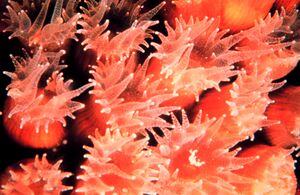
The polyps of stony corals have six-fold symmetry. In stony corals, the tentacles are cylindrical and taper to a point, but in soft corals they are pinnate with side branches known as pinnules. In some tropical species, these are reduced to mere stubs and in some, they are fused to give a paddle-like appearance.[14]
Coral skeletons are biocomposites (mineral + organics) of calcium carbonate, in the form of calcite or aragonite. In scleractinian corals, "centers of calcification" and fibers are clearly distinct structures differing with respect to both morphology and chemical compositions of the crystalline units.[15][16] The organic matrices extracted from diverse species are acidic, and comprise proteins, sulphated sugars and lipids; they are species specific.[17] The soluble organic matrices of the skeletons allow to differentiate zooxanthellae and non-zooxanthellae specimens.[18]
شكل المستعمرة
البَوْلَب
الهيكل الخارجي

اللوامس
البيئة
التغذية
Zooxanthellae symbiote
التكاثر
الجنس
Broadcasters
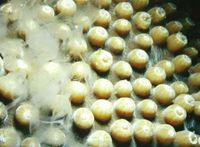
الحظائر
Planulae
اللاجنسي
تقسيم المستعمرات
الشعاب
التاريخ التطوري
| ||
| ||
| ||
| ||
| Horn coral fossil. |
 | |
|
Timeline of the major coral fossil record and developments from 650 m.y.a. to present.[19][20] |
|
الوضع
الأخطار
الحماية
علاقتها بالإنسان
الحلي
الإنشاءات
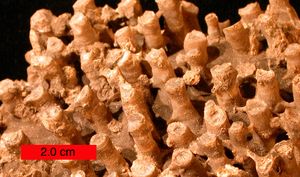
بحوث المناخ
الاستزراع المائي
انظر أيضا
- Bamboo coral
- Coral dermatitis
- Coral Triangle
- Organ pipe coral
- Sea Turtle Association of Japan, Kuroshima Research Station
معرض الصور
Further images: commons:Category:Coral reefs and commons:Category:Coral
Staghorn coral, Acropora
Fringing coral reef off the coast of Eilat, Israel.
Glass bottom boats and a Semi submarine which are used for coral viewing at Green Island (Queensland), Great Barrier Reef, Australia
المصادر
- ^ عبد الجليل هويدي، محمد أحمد هيكل (2004). أساسيات الجيولوجيا التاريخية. مكتبة الدار العربية للكتب.
- ^ Squires, D.F. (1959). "Deep sea corals collected by the Lamont Geological Observatory. 1. Atlantic corals" (PDF). American Museum Novitates (1965): 23.
- ^ Leroi, Armand Marie (2014). The Lagoon: How Aristotle Invented Science. Bloomsbury. p. 271. ISBN 978-1-4088-3622-4.
- ^ أ ب ت Bowen, James (2015). The Coral Reef Era: From Discovery to Decline: A history of scientific investigation from 1600 to the Anthropocene Epoch. Springer. pp. 5–7. ISBN 978-3-319-07479-5.
- ^ Babylonian Talmud, Rosh Hashana 23a, and commentary of Rashi (24th narrow line)
- ^ Egerton, Frank N. (2012). Roots of Ecology: Antiquity to Hackel. University of California Press. p. 24. ISBN 978-0-520-95363-5.
- ^ Swett, C. (5 March 2020). Corals: Secrets of Their Reef-Making Colonies. Capstone Global Library Ltd. ISBN 9781474771009.
- ^ Hoeksema, Bert (2015). "Anthozoa". WoRMS. World Register of Marine Species. Retrieved 2015-04-24.
- ^ أ ب ت Ruppert, Edward E.; Fox, Richard, S.; Barnes, Robert D. (2004). Invertebrate Zoology, 7th edition. Cengage Learning. pp. 132–48. ISBN 978-81-315-0104-7.
{{cite book}}: CS1 maint: multiple names: authors list (link) - ^ أ ب ت ث One or more of the preceding sentences incorporates text from a publication now in the public domain: Minchin, Edward Alfred (1911). . In Chisholm, Hugh (ed.). دائرة المعارف البريطانية. Vol. 22 (eleventh ed.). Cambridge University Press. p. 37.
{{cite encyclopedia}}: Cite has empty unknown parameter:|coauthors=(help) - ^ D. Gateno; A. Israel; Y. Barki; B. Rinkevich (1998). "Gastrovascular Circulation in an Octocoral: Evidence of Significant Transport of Coral and Symbiont Cells". The Biological Bulletin. 194 (2): 178–86. doi:10.2307/1543048. JSTOR 1543048. PMID 28570841.
- ^ Peel, John S. (2017). "A problematic cnidarian (Cambroctoconus; Octocorallia?) from the Cambrian (Series 2–3) of Laurentia". Journal of Paleontology. 91 (5): 871–882. doi:10.1017/jpa.2017.49. S2CID 134826884.
- ^ Administration, US Department of Commerce, National Oceanic and Atmospheric. "existing and potential value of coral ecosystems with respect to income and other economic values". coralreef.noaa.gov (in الإنجليزية الأمريكية). Archived from the original on 2018-02-05. Retrieved 2018-02-04.
{{cite web}}: CS1 maint: multiple names: authors list (link) - ^ Sprung, Julian (1999). Corals: A quick reference guide. Ricordea Publishing. p. 145. ISBN 978-1-883693-09-1.
- ^ Cuif, J.P.; Dauphin, Y. (1998). "Microstructural and physico-chemical characterization of 'centers of calcification' in septa of some Recent scleractinian corals". Paläontologische Zeitschrift. 72 (3–4): 257–269. doi:10.1007/bf02988357. ISSN 0031-0220. S2CID 129021387.
- ^ Cuif, J.P.; Dauphin, Y.; Doucet, J.; Salomé, M.; Susini, J. (2003). "XANES mapping of organic sulfate in three scleractinian coral skeletons". Geochimica et Cosmochimica Acta. 67 (1): 75–83. Bibcode:2003GeCoA..67...75C. doi:10.1016/s0016-7037(02)01041-4. ISSN 0016-7037.
- ^ Dauphin, Y.; Cuif, J.P.; Williams, C. T. (2008). "Soluble organic matrices of aragonitic skeletons of Merulinidae (Cnidaria, Anthozoa)". Comparative Biochemistry and Physiology Part B: Biochemistry and Molecular Biology. 150 (1): 10–22. doi:10.1016/j.cbpb.2008.01.002. ISSN 1096-4959. PMID 18325807.
- ^ Cuif, J.P.; Dauphin, Y.; Freiwald, A.; Gautret, P.; Zibrowius, H. (1999). "Biochemical markers of zooxanthellae symbiosis in soluble matrices of skeleton of 24 Scleractinia species". Comparative Biochemistry and Physiology Part A: Molecular & Integrative Physiology. 123 (3): 269–278. doi:10.1016/s1095-6433(99)00059-8. ISSN 1095-6433.
- ^ Ben M. Waggoner (2000). David Smith and Allen Collins:Anthozoa: Fossil Record. Anthozoa. UCMP. Retrieved on 2009-03-23.
- ^ William A. Oliver, Jr. (2003). Corals: Table 1. Fossil Groups. USGS. Retrieved on 2009-03-23.
قراءات للإستزادة
- Coral Reefs The Ocean Portal by Smithsonian Institution.
- Coral, The Reef & Marine Aquarium Magazine. ISSN 1556-5769 Coral Magazine
- Book of Coral Propagation by Anthony Calfo. ISBN 0-9802365-0-9
- Coral Reefs of the World by Susan Wells
- Corals of the World: Biology and Field Guide by Surrey Redhill
- Marine Biology, An Ecological Approach, 6th edition, Nybakken, J.W. 2004. ISBN 0-8053-4582-5
- Indo-Pacific Coral Reef Field Guide by Allen, G.R & R. Steene. 1994. ISBN 981-00-5687-7
- Coral Reef Animals of the Indo-Pacific, Animals Life from Africa to Hawai‘i (invertebrates) by Gosliner, T., D. Behrens & G. Williams. 1996. ISBN 0-930118-21-9
- Tropical Pacific Invertebrates by Colin, P.L. & C. Arneson. 1995. ISBN 0-9645625-0-2
- Corals of Australia and the Indo-Pacific by Veron, J.E.N. 1993. ISBN 0-8248-1504-1
- The Evolution of Reef Communities by Fagerstrom, J.A. 1987. ISBN 0-471-81528-4
- A Reef Comes to Life. Creating an Undersea Exhibit by Segaloff, Nat, and Paul Erickson. 1991. ISBN 0-531-10994-1
- SeaWorld – Coral reef bibliography
وصلات خارجية
|
- What is a coral?
- NOAA CoRIS – Coral Reef Biology
- NOAA Ocean Service Education – Corals
- University of Southern Mississippi – Coral Reef Resource Guide
- Hard Corals Order:Scleractinia From Gulf of Kutch
- Coral Reproduction at the Smithsonian Ocean Portal
- صفحات تستخدم خطا زمنيا
- مقالات المعرفة المحتوية على معلومات من دائرة المعارف البريطانية طبعة 1911
- Wikipedia articles incorporating text from the 1911 Encyclopædia Britannica
- CS1 الإنجليزية الأمريكية-language sources (en-us)
- Short description is different from Wikidata
- Automatic taxobox cleanup
- Articles with hatnote templates targeting a nonexistent page
- مقالات جيدة
- Anthozoa
- Incremental dating
- شعاب مرجانية
